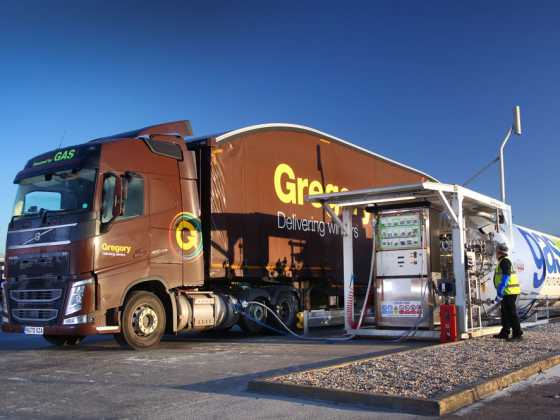Will LNG fulfil its European potential?
Liquefied Natural Gas (LNG) has been used as a clean burning alternative vehicle fuel in thousands of trucks, and other vehicles in the United States for decades. With the long running challenge to diesel and petrol vehicles growing in the UK, is it time for LNG to become a mainstream fuel?

Liquefied Natural Gas (LNG) is natural gas, predominantly methane, that has been cryogenically cooled to its liquid state. It is the same gas that is piped throughout the UK for domestic use but, by cryogenically cooling the gas to -162°C, its volume is reduced making it easier to store. It is odourless, colourless, non-toxic and non-corrosive.
While knowledge of LNG is becoming more widespread, its use in vehicles and transportation is relatively reserved to those in the field – that is to say that it is yet to become a mainstream fuel. However, when we analyse its usage in the transport across the globe, notably China, it becomes necessary to question why this is still the case.
As of September 2014, China, which has the largest and fastest growing natural gas bus fleet in the world, registered 100,000 LNG powered vehicles on its roads, making it a world leading example of how the gas can be explored on a global scale.
In February this year, across the pond, the United States introduced an alternative fuelling centre tracking site showing 69 public truck LNG fuel centres. Additionally, the 2013 National Trucker’s Directory listed roughly 7,000 truck stops, equating one per cent of US truck stops, which have LNG available.
European uncertainty
The growth of LNG in Europe is more difficult to trace, as it is very much far away from being the fuel of choice amongst fleet operators.
This year the Netherlands introduced LNG powered trucks into the nation’s transport sector. Building on the Gas Access to Europe (GATE) supply infrastructure in the Port of Rotterdam, oil and gas company Shell, intends to build a supply network for trucks and barges in Northwest Europe.
The first European Shell LNG Station is now open in Rotterdam, Waalhaven, for trucks operating in Europe. The station is located near the A15, which is a major route for lorries travelling to Belgium, France, and the German Ruhr area.
The new station has a capacity of 70,000 litres of LNG, and can provide 170 trucks with LNG on a daily basis. SUEZ Environnement NL, Vos Logistics and ABS Trucking were among the first customers to use the station. Together with launching partners SUEZ Environnement NL (formerly SITA NL) and Volvo Trucks, Shell plans to put LNG as a truck fuel on the market.
Giorgio Delpiano, General Manager Commercial Fleet, said: “It’s great to see customers now fill their trucks with LNG at the Shell gas station, where customers previously could refuel all Fuel Save Diesel and GTL Fuel. We are proud to take the lead in the development of safe and cost efficient LNG fuel technology.”
Shell intends to open more LNG stations in the Netherlands when demand for the fuel increases.
Lauran Wetemans, General Manager Downstream LNG, Shell, added: “LNG fuel may be an interesting option for transportation. We expect LNG is going to get a larger share in the future fuel mix, and we continue to work with engine manufacturers, customers and policy makers to promote the use of LNG as a transport fuel.”
LNG advantages
Natural gas-fuelled engines have high credentials. They are clean, in abundant supply and economical. Compared with petrol or diesel, biogas can reduce the carbon footprint of a vehicle by up to 80 per cent and has the capability to provide a completely carbon-neutral fuel supply. LNG burns almost completely, leaving only a small amount of carbon dioxide and water behind.
According to American company REV LNG, the gas produces up to 90 per cent lower emissions than diesel. Due to its weight, in the event of a spill, LNG disperses quickly without pooling on the ground creating a fire hazard like petroleum based fuels. It also has a higher ignition temperature making it less flammable than gasoline or diesel.
Additionally, LNG fuels as fast as diesel at 40 gallons per minute, while CNG ‘Slow Fill’ takes six – eight hours and ‘Fast Fill’ takes 30-45 minutes, but only half the tank can be filled because of heat and pressure builds.
LNG is the only option for a truck that needs to go more than 200 miles. Compressed Natural Gas (CNG) trucks are required to add multiple tanks that add excessive weight and cost to get to the same range as a LNG vehicle. LNG vehicles can store as much as 2.5 times the fuel in the same space as conventional CNG systems, which increases fuel efficiency and range. LNG also offers engines that are above 400 HP, encouraging the belief that heavy loads are better pulled by LNG vehicles and not CNG.
LNG vehicles unpopularity?
For all of LNG’s positive credentials, ultimately cost and availability work against it. Despite LNG reportedly costing on average 50 per cent less than diesel fuel, natural gas vehicles are more expensive than diesel alternatives and are not as readily available in the UK compared to say Asia.
In the UK, companies can convert their diesel lorries to run on a dual fuel basis, which would require a much smaller investment than buying new lorries, however the cost remains very unappealing. Conversions can cost anywhere from £19,000 to £26,000 per vehicle. This amounts to a huge cost especially if you have a large fleet. In an industry where prices are fiercely competitive and margins are low the costs are just too high.
On top of those, the high cost of cryogenic storage on vehicles and the major infrastructure requirement of LNG dispensing stations, production plants and transportation facilities also impose disadvantages.
A leap of faith
There also remains doubt over the feasibility of LNG, due to the lack of government support. In Belgium, for example, they do not tax LNG when it is used as a fuel for motor vehicles. Key industry representatives across Europe, who met at last years NGV Europe Conference in Amsterdam, remain worried that governments will start to raise the duty before the sector has had a chance to really take off.
At the Conference, Federico Giovanetti, alternative fuels product manager at Iveco, said: “We need policymakers to set medium to long term tax measures.”
It is strongly, albeit quietly, believed that LNG has cheap longevity in the transport industry, but for fleet managers, switching from a tried and tested fuel such as diesel to LNG would require a leap of faith.
Not all UK companies are completely against LNG, with supermarket chains Tesco and Sainsbury’s having flirted with the LNG lorry market, although their NGV’s only make up a miniscule proportion of their fleet.
More impressively, Asda Logistics Services’ has opened its LNG refuelling station in Avonmouth, Bristol, to third party use, adding to the UK network of natural gas stations available to heavy truck operators with LNG fleets.
Stuart Milligan for Asda commented: “We have been really fortunate to be in a position where we are working with companies such as BOC and Volvo; using new technology to both reduce costs and our carbon footprint.
“We have a fantastic facility from BOC and it would be great to use it to support a wider LNG network.”
The dedicated dual-fuel LNG refuelling station at Asda Logistics Services was opened last year and incorporates the latest ‘zero loss’ refuelling technology, developed by BOC, which uses cryogenic cooling to ‘temperature‑condition’ the fuel just prior to dispensing.
The refuelling station supports the UK supermarket chain’s fleet of 52 dual-fuel Volvo trucks at the site and is the latest development in Asda’s transport sustainability strategy, which includes a target to reduce emissions from its transport fleet by 60 per cent (between 2005 and 2015). L
Further Information
www.revlng.com






